Abstract
1 Intracerebroventricular injection of prostanglandin F2alpha (10-40 microgram) decreases food intake in a dose-dependent manner in rats trained to consume their daily total food intake in a 2 h period. 2 This anorexia is also observed in satiated rats, which had ad libitum access to food. 3 The anorectic activity of prostaglandin F2alpha is not modified by changes in the internal environment of the body after food intake, such as increased blood glucose and insulin levels and decreased fatty acid levels, or by the presence or absence of food in the stomach, as is evident from the anorectic activity of prostaglandin F2alpha in partially satiated rats. 4 The anorexia is not due to pain or irritative properties of prostaglandin F2alpha since induction of comparable pain with 3% acetic acid does not affect food intake in rats deprived of food for 22 hours. 5 Anorectic doses of prostaglandin F2alpha when injected intraperitoneally cause hypothermia. 6 The results suggest that the inhibitory activity of prostaglandin F2alpha on food intake is at both peripheral and central sites. 7 Prostaglandin F2alpha-induced anorexia is associated with the behavioural tranquilization that is seen after the ingestion of food.
Full text
PDF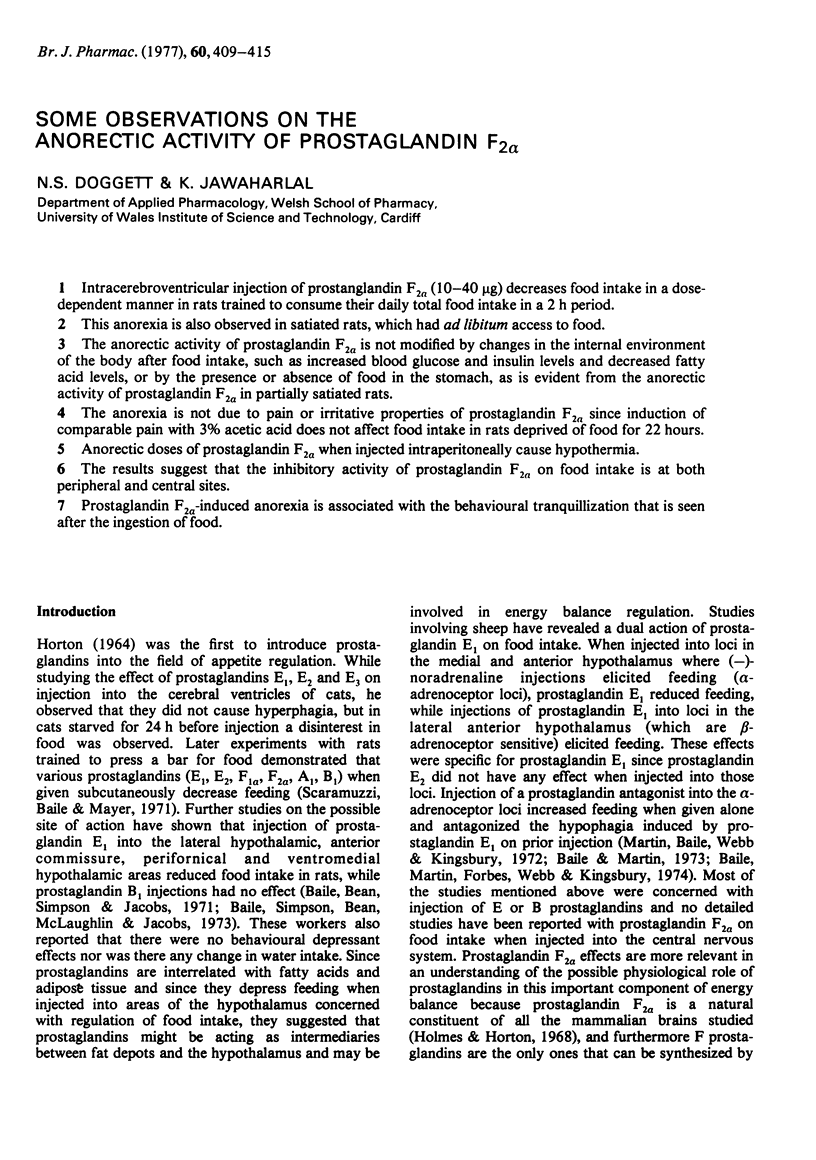
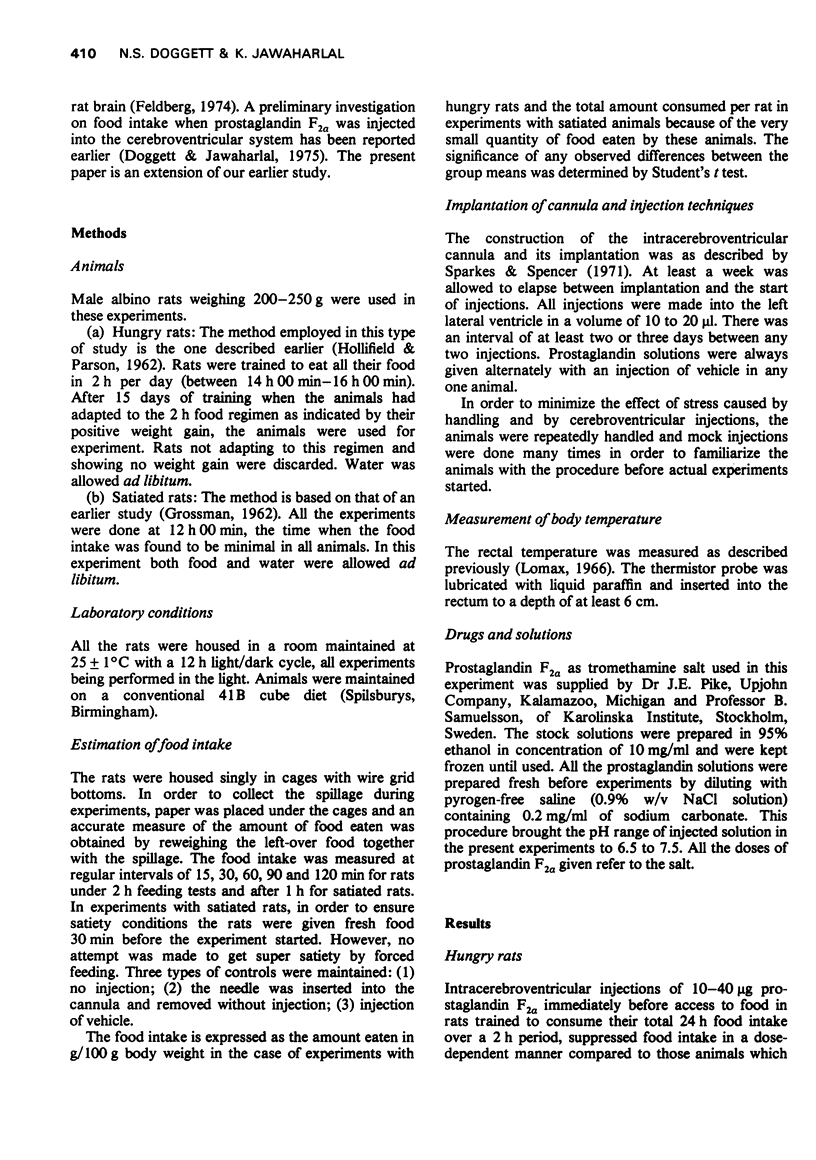
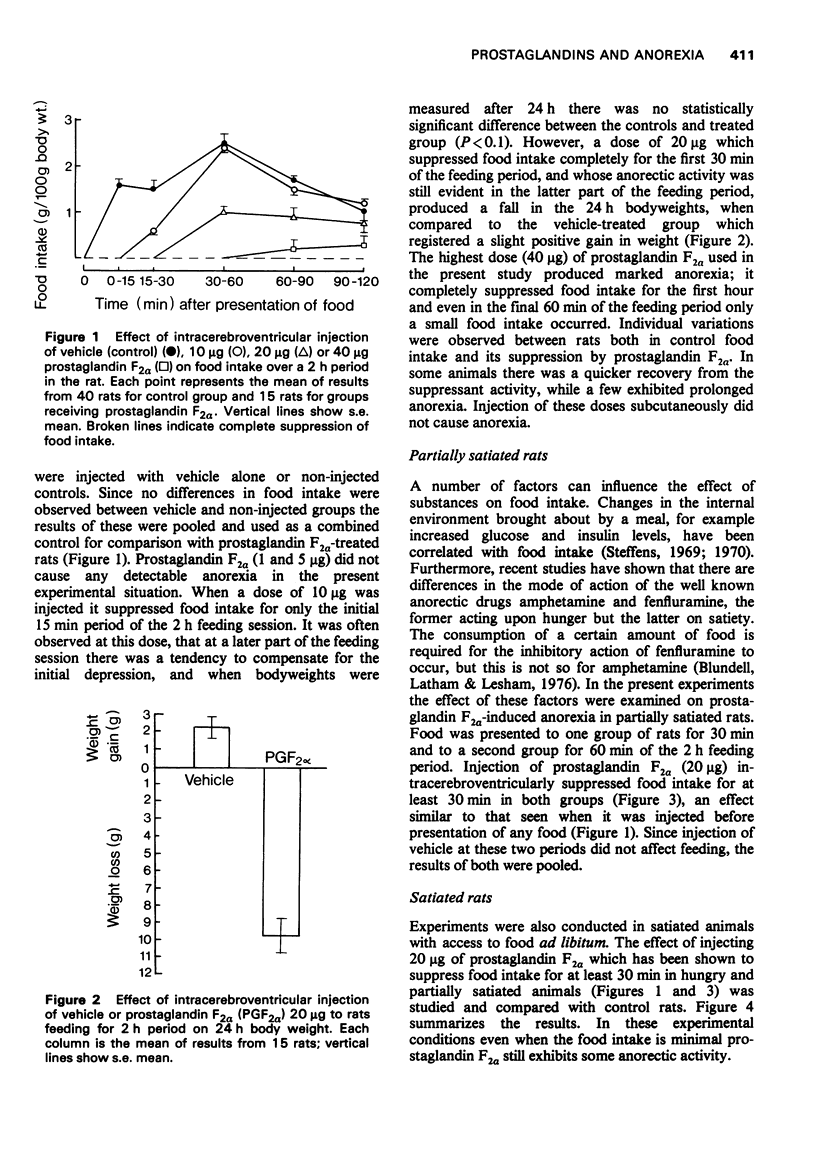
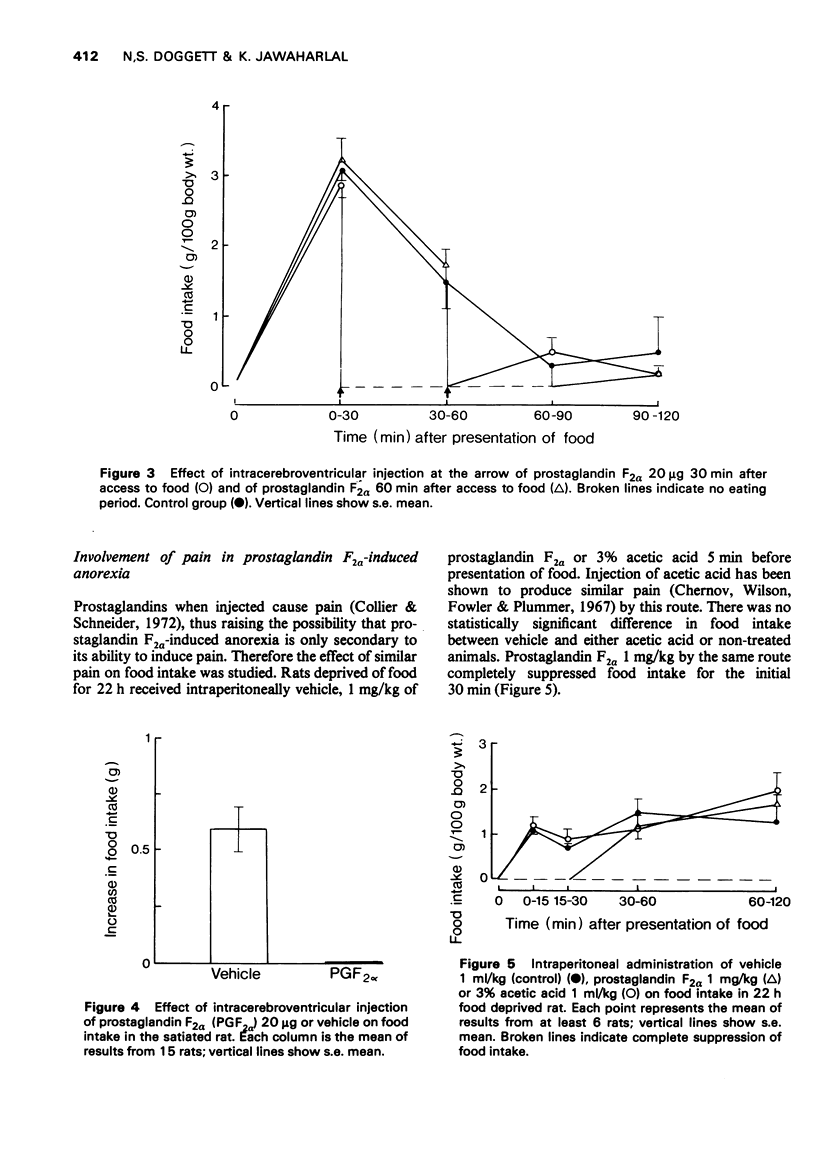
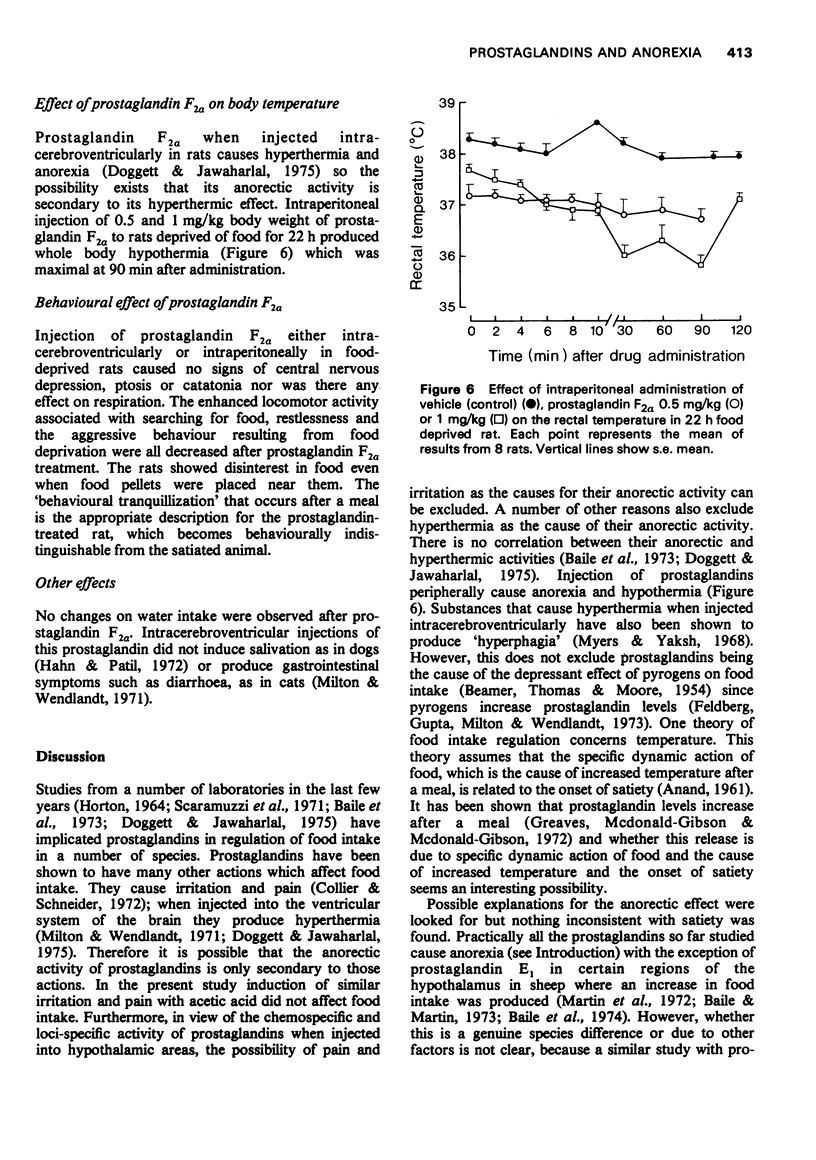
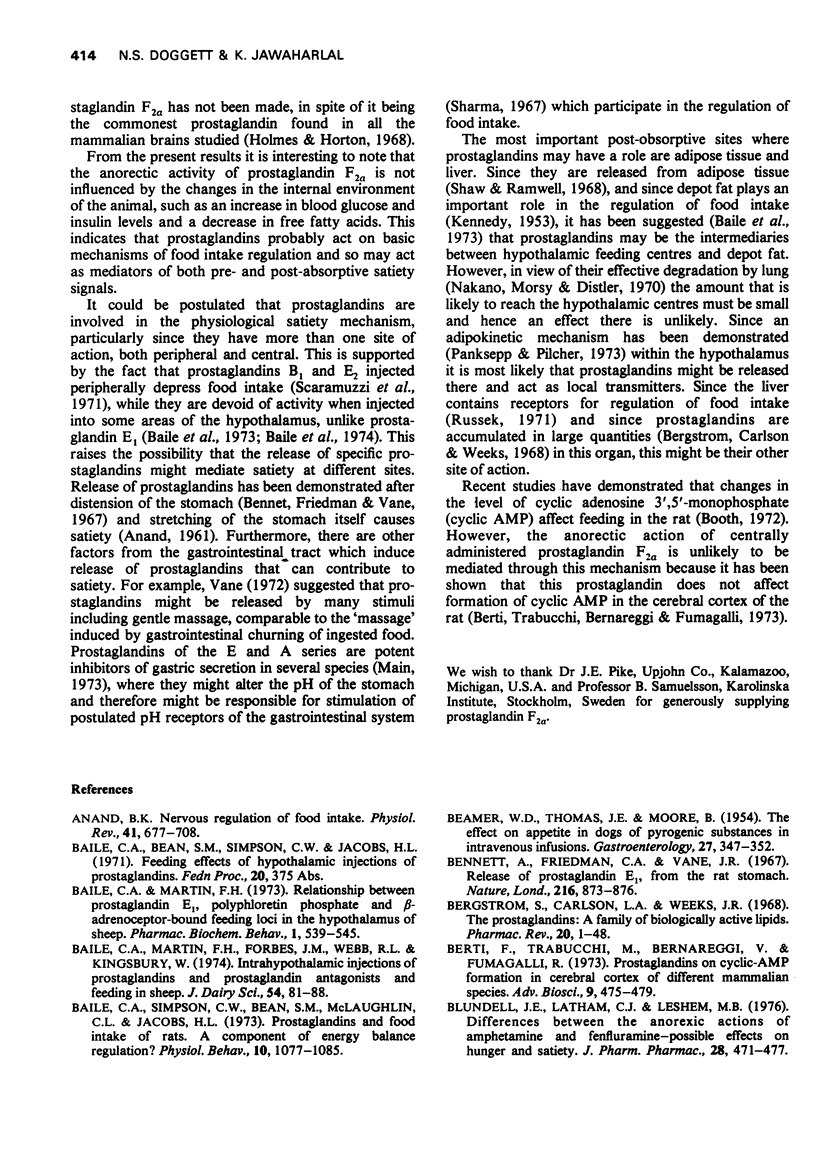
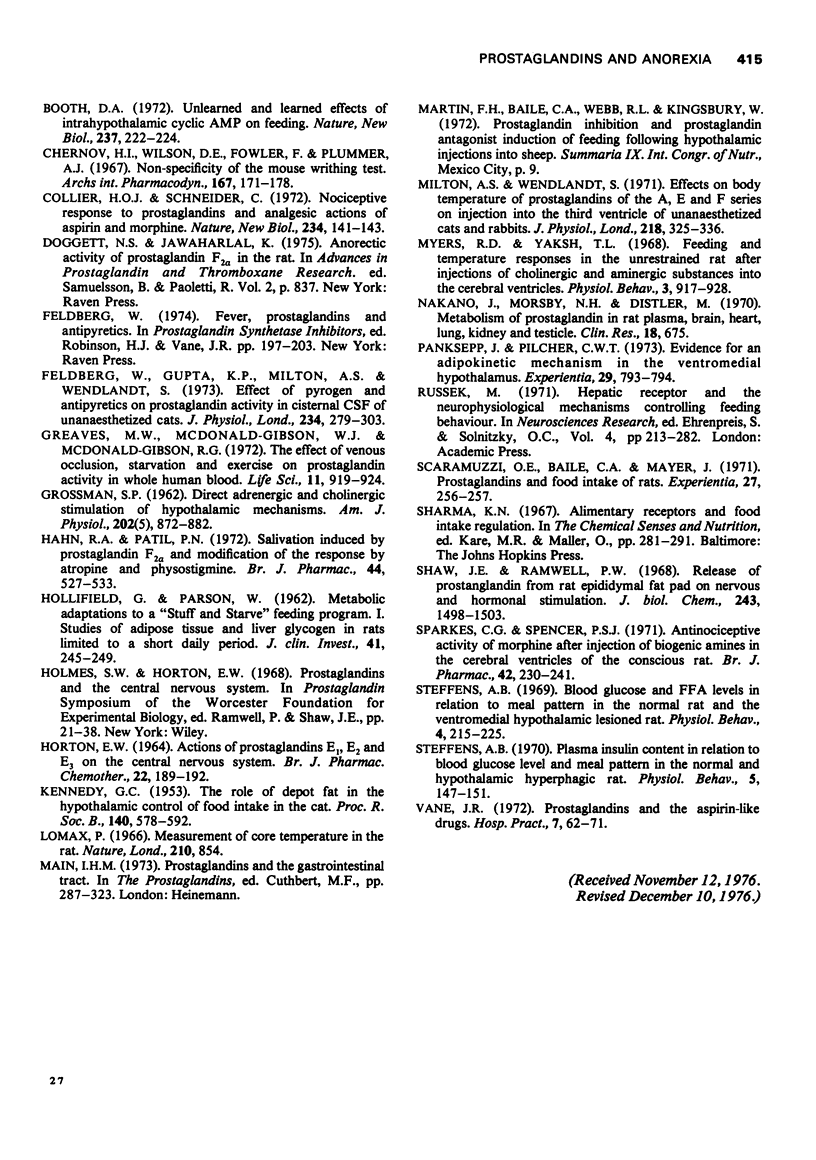
Selected References
These references are in PubMed. This may not be the complete list of references from this article.
- ANAND B. K. Nervous regulation of food intake. Physiol Rev. 1961 Oct;41:677–708. doi: 10.1152/physrev.1961.41.4.677. [DOI] [PubMed] [Google Scholar]
- BEAMER W. D., THOMAS J. E. The effect on appetite in dogs of pyrogenic substances in intravenous infusions. Gastroenterology. 1954 Sep;27(3):347–352. [PubMed] [Google Scholar]
- Baile C. A., Martin F. H., Forbes J. M., Webb R. L., Kingsbury W. Intrahypothalamic injections of prostaglandins and prostaglandin antagonists and feeding in sheep. J Dairy Sci. 1974 Jan;57(1):81–88. doi: 10.3168/jds.s0022-0302(74)84834-4. [DOI] [PubMed] [Google Scholar]
- Baile C. A., Martin F. H. Relationship between prostagandin E1, polyphloretin phosphate and alpha and beta adrenoceptor-bound feeding loci in the hypothalamus of sheep. Pharmacol Biochem Behav. 1973 Sep-Oct;1(5):539–545. doi: 10.1016/0091-3057(73)90078-6. [DOI] [PubMed] [Google Scholar]
- Baile C. A., Simpson C. W., Bean S. M., McLaughlin C. L., Jacobs H. L. Prostaglandins and food intake of rats: a component of energy balance regulation? Physiol Behav. 1973 Jun;10(6):1077–1085. doi: 10.1016/0031-9384(73)90191-1. [DOI] [PubMed] [Google Scholar]
- Bennett A., Friedmann C. A., Vane J. R. Release of prostaglandin E-1 from the rat stomach. Nature. 1967 Dec 2;216(5118):873–876. doi: 10.1038/216873a0. [DOI] [PubMed] [Google Scholar]
- Bergström S., Carlson L. A., Weeks J. R. The prostaglandins: a family of biologically active lipids. Pharmacol Rev. 1968 Mar;20(1):1–48. [PubMed] [Google Scholar]
- Blundell J. E., Latham C. J., Leshem M. B. Differences between the anorexic actions of amphetamine and fenfluramine--possible effects on hunger and satiety. J Pharm Pharmacol. 1976 Jun;28(6):471–477. doi: 10.1111/j.2042-7158.1976.tb02768.x. [DOI] [PubMed] [Google Scholar]
- Booth D. A. Unlearned and learned effects of intrahypothalamic cyclic AMP injection on feeding. Nat New Biol. 1972 Jun 14;237(76):222–224. doi: 10.1038/newbio237222a0. [DOI] [PubMed] [Google Scholar]
- Chernov H. I., Wilson D. E., Fowler W. F., Plummer A. J. Non-specificity of the mouse writhing test. Arch Int Pharmacodyn Ther. 1967 May;167(1):171–178. [PubMed] [Google Scholar]
- Collier H. O., Schneider C. Nociceptive response to prostaglandins and analgesic actions of aspirin and morphine. Nat New Biol. 1972 Apr 5;236(66):141–143. doi: 10.1038/newbio236141a0. [DOI] [PubMed] [Google Scholar]
- Feldberg W., Gupta K. P., Milton A. S., Wendlandt S. Effect of pyrogen and antipyretics on prostaglandin acitvity in cisternal c.s.f. of unanaesthetized cats. J Physiol. 1973 Oct;234(2):279–303. doi: 10.1113/jphysiol.1973.sp010346. [DOI] [PMC free article] [PubMed] [Google Scholar]
- GROSSMAN S. P. Direct adrenergic and cholinergic stimulation of hypothalamic mechanisms. Am J Physiol. 1962 May;202:872–882. doi: 10.1152/ajplegacy.1962.202.5.872. [DOI] [PubMed] [Google Scholar]
- Greaves M. W., McDonald-Gibson W. J., McDonald-Gibson R. G. The effect of venous occlusion, starvation and exercise on prostaglandin activity in whole human blood. Life Sci II. 1972 Sep 22;11(18):919–924. doi: 10.1016/0024-3205(72)90028-8. [DOI] [PubMed] [Google Scholar]
- HOLLIFIELD G., PARSON W. Metabolic adaptations to a "stuff and starve" feeding program. I. Studies of adipose tissue and liver glycogen in rats limited to a short daily feeding period. J Clin Invest. 1962 Feb;41:245–249. doi: 10.1172/JCI104476. [DOI] [PMC free article] [PubMed] [Google Scholar]
- HORTON E. W. ACTIONS OF PROSTAGLANDINS E1, E2 AND E3 ON THE CENTRAL NERVOUS SYSTEM. Br J Pharmacol Chemother. 1964 Feb;22:189–192. doi: 10.1111/j.1476-5381.1964.tb01558.x. [DOI] [PMC free article] [PubMed] [Google Scholar]
- Hahn R. A., Patil P. N. Salivation induced by prostaglandin F 2 and modification of the response by atropine and physostigmine. Br J Pharmacol. 1972 Mar;44(3):527–533. doi: 10.1111/j.1476-5381.1972.tb07289.x. [DOI] [PMC free article] [PubMed] [Google Scholar]
- KENNEDY G. C. The role of depot fat in the hypothalamic control of food intake in the rat. Proc R Soc Lond B Biol Sci. 1953 Jan 15;140(901):578–596. doi: 10.1098/rspb.1953.0009. [DOI] [PubMed] [Google Scholar]
- Lomax P. Measurement of 'core' temperature in the rat. Nature. 1966 May 21;210(5038):854–855. doi: 10.1038/210854a0. [DOI] [PubMed] [Google Scholar]
- Milton A. S., Wendlandt S. Effects on body temperature of prostaglandins of the A, E and F series on injection into the third ventricle of unanaesthetized cats and rabbits. J Physiol. 1971 Oct;218(2):325–336. doi: 10.1113/jphysiol.1971.sp009620. [DOI] [PMC free article] [PubMed] [Google Scholar]
- Panksepp J., Pilcher C. W. Evidence for an adipokinetic mechanism in the ventromedial hypothalamus. Experientia. 1973;29(7):793–794. doi: 10.1007/BF01946289. [DOI] [PubMed] [Google Scholar]
- Russek M. Hepatic receptors and the neurophysiological mechanisms controlling feeding behavior. Neurosci Res (N Y) 1971;4:213–282. doi: 10.1016/b978-0-12-512504-8.50012-3. [DOI] [PubMed] [Google Scholar]
- Scaramuzzi O. E., Baile C. A., Mayer J. Prostaglandins and food intake of rats. Experientia. 1971 Mar 15;27(3):256–257. doi: 10.1007/BF02138130. [DOI] [PubMed] [Google Scholar]
- Shaw J. E., Ramwell P. W. Release of prostaglandin from rat epididymal fat pad on nervous and hormonal stimulation. J Biol Chem. 1968 Apr 10;243(7):1498–1503. [PubMed] [Google Scholar]
- Sparkes C. G., Spencer P. S. Antinociceptive activity of morphine after injection of biogenic amines in the cerebral ventricles of the conscious rat. Br J Pharmacol. 1971 Jun;42(2):230–241. doi: 10.1111/j.1476-5381.1971.tb07104.x. [DOI] [PMC free article] [PubMed] [Google Scholar]
- Steffens A. B. Plasma insulin content in relation to blood glucose level and meal pattern in the normal and hypothalamic hyperphagic rat. Physiol Behav. 1970 Feb;5(2):147–151. doi: 10.1016/0031-9384(70)90058-2. [DOI] [PubMed] [Google Scholar]


